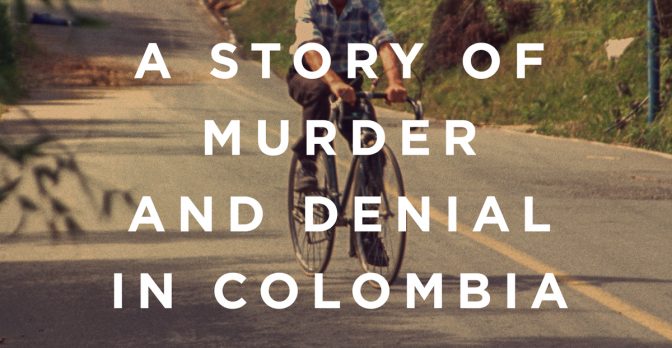Review: Maria McFarland’s ‘There Are No Dead Here’

Drug Policy Alliance executive director Maria McFarland Sánchez-Moreno, a veteran Latin America specialist with Human Rights Watch, tells a grim but also inspiring story in There Are No Dead Here: A Story of Murder and Denial in Colombia (Nation Books). It details the efforts of three courageous Colombians to bring to light official complicity in the reign of paramilitary terror in the country over the past generation.
These three won a measure of success, but at the cost of relentless death threats and assassination attempts. One paid the proverbial ultimate price. Their interlocking tales paint a picture of Colombian officials’ staggering cynicism, especially during the 2002-2010 presidency of Álvaro Uribe, whose administration was thoroughly integrated with the ostensibly illegal right-wing paramilitary networks, even as he denied everything and portrayed himself as a centrist democrat.

Author and DPA head Maria McFarland Sánchez-Moreno
The book opens with the figure who became a martyr in the quest for truth—Jesús Maria Valle, an attorney and human-rights defender in the city of Medellín, who was among the first to raise the alarm about the mounting paramilitary violence in the 1990s. Uribe was then governor of the department of Antioquia, where Medellín is located. Valle initially tried to alert him about the violence in rural communities, before determining that the governor’s own anti-guerilla militia force was cooperating with the paras. In 1998, armed men invaded Valle’s office and assassinated him.
Antioquia proved to be a testing ground for the strategy Uribe would apply nationally as president. Iván Velásquez, the prosecutor and jurist who doggedly investigated the Uribe government’s collaboration with paramilitary groups, picked up Valle’s torch. Uribe road-blocked Velásquez every step of the way, launching a media smear campaign against him, while paras operated in the shadows with threats and attacks on his team.
Velásquez was greatly aided by the work of Ricardo Calderón, an investigative journalist with Bogotá’s Semana newsweekly. Calderón eventually concluded that Uribe’s intelligence agency, the Department of Administrative Security (DAS) was working closely with the paras, spying on judges, journalists and opposition politicians, and feeding the information back to the illegal and ultra-murderous right-wing militias. This became a major scandal in Colombia, and in a measure of justice, DAS was disbanded in 2011.
With Uribe out of office and the paramilitaries officially disarmed under a political deal with their leadership, some of the para leaders—now extradited to the United States and doing time on cocaine charges—started to sing. The big boss of the network, Salvatore Mancuso, came clean from his U.S. federal prison cell on Uribe’s effective collaboration with the paras during his time in power.
 EXCERPT: “Starting in the late 1990s, the paramilitaries carried out a bloody expansion campaign throughout much of Colombia. Fueled by an endless stream of drug profits, they committed gruesome massacres in the name of defending the country from the brutal Marxist guerillas of FARC… Nobody, it seemed, was trying to stop them.”
EXCERPT: “Starting in the late 1990s, the paramilitaries carried out a bloody expansion campaign throughout much of Colombia. Fueled by an endless stream of drug profits, they committed gruesome massacres in the name of defending the country from the brutal Marxist guerillas of FARC… Nobody, it seemed, was trying to stop them.”
But Uribe, maddeningly, is free today and continues to lead Colombia’s right-wing opposition. In 2016, when new President Juan Manuel Santos negotiated a peace deal with the left-wing guerillas of the FARC, Uribe campaigned bitterly against it. The book ends on a tentative note of hope, as the peace deal with the FARC goes ahead despite the best efforts of Uribe to sabotage it.
The story McFarland tells is an important one, but with the relentless accounts of assassinations and atrocities, it’s easy to lose the narrative thread. More serious is her cursory portrayal of what the fighting was all about, particularly the role of Colombia’s narco-economy. She writes that the government’s war on the cocaine cartels was a “parallel” conflict to that of the civil war that pitted the FARC against the security forces and their paramilitary allies. But after the cartels were crushed, the “drug war” and the civil war were really the same war. The demise of Medellín kingpin Pablo Escobar and his Cali-cartel competition in the ’90s set the stage for the paras and the guerillas to enter into a direct struggle with each other for control of the cocaine economy. It’s the key to real political power in Colombia, and McFarland little mention of this.
Finally, there’s little mention of “Plan Colombia,” the massive U.S. military aid package that backed Uribe’s armed forces through the bloodiest years of the conflict when state collaboration with the paramilitaries was at its peak. The story of Washington’s complicity in Colombia’s state terror is one that still needs to be told.
If you enjoyed this Freedom Leaf article, subscribe to the magazine today!

